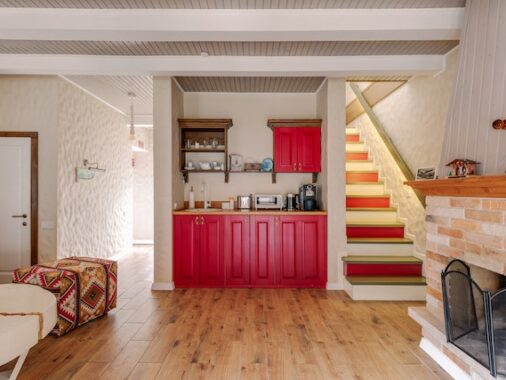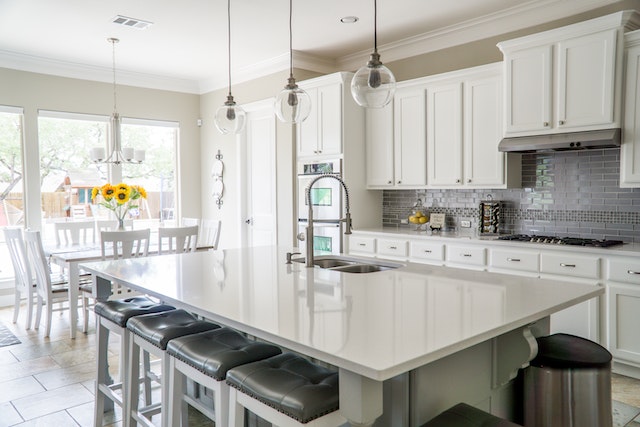A dining room rug is an essential element of interior design that can add style and practicality to your dining space. It can anchor the room, define the space, and create a cozy and inviting atmosphere for meals and gatherings. In addition to its decorative value, a dining room rug can also protect your flooring from scratches, dents, and spills, making it a functional addition to any home. Whether you prefer a classic, transitional, or contemporary style, there is a dining room rug that can suit your taste and needs. In this article, we’ll explore the different styles of dining room rugs and offer tips on how to choose the perfect rug for your space.
Classic Style
A classic dining room rug exudes timeless elegance and sophistication. It typically features intricate patterns and muted colors that complement traditional decor. Some of the characteristics of a classic dining room rug include:
- Ornate patterns: Classic rugs often feature intricate floral or geometric patterns, which can be achieved through weaving, embroidery, or printing.
- Muted colors: Classic rug colors tend to be subdued, with shades of red, gold, navy, and beige being the most popular.
- High-quality materials: A classic rug is typically made from high-quality materials like wool, silk, or cotton, which are durable and long-lasting.
Some examples of classic rug patterns and colors include:
- Persian rugs: These rugs are known for their intricate floral patterns and rich, deep colors, such as red, navy, and gold.
- Oriental rugs: Similar to Persian rugs, oriental rugs feature detailed patterns and a range of warm, muted colors.
- Aubusson rugs: These French-inspired rugs are known for their intricate floral and scrollwork patterns, often in pastel colors.
To pair a classic rug with traditional furniture, you should:
- Consider the style of your furniture: If you have ornate, traditional furniture, a classic rug can complement its elegance and bring out its beauty.
- Choose complementary colors: Look for a rug that has colors that coordinate with the colors in your furniture or decor.
- Pay attention to scale: Make sure your rug is appropriately sized for your dining room and complements the scale of your furniture.
To create a classic dining room look, you can:
- Opt for a large, ornate chandelier as a centerpiece
- Add traditional accents like candlesticks or crystal glasses
- Hang drapery or curtains in a classic style, such as damask or silk
- Incorporate wood elements, such as a dark wood dining table or chair frames
Transitional Style
The transitional style is a blend of traditional and contemporary design elements, creating a timeless and sophisticated look that is neither too formal nor too casual. It differs from classic style in that it incorporates more modern elements, and from contemporary style in that it is not as minimalistic or stark.
When choosing a transitional rug for a dining room, it is important to consider the following:
- Color: Transitional rugs often feature a mix of warm and cool colors, such as beige, gray, or taupe. Look for colors that complement your existing decor and create a cohesive look.
- Pattern: Transitional rugs may feature a more subdued pattern or a mix of traditional and modern elements. Consider your personal style and how the rug will work with your furniture.
- Texture: Transitional rugs may incorporate a mix of textures, such as wool and silk or flatweave and plush. Look for a rug with a texture that complements your dining room furniture.
Some suggestions for transitional rug patterns and colors include:
- Geometric patterns: A transitional rug may feature a modern geometric pattern, but in muted colors such as gray or beige.
- Abstract patterns: A transitional rug may feature a subtle abstract pattern, such as brush strokes or watercolor, that blends traditional and modern design elements.
- Neutral colors: Transitional rugs often feature neutral colors that blend well with a range of decor styles, such as beige, gray, or taupe.
To mix transitional and modern elements in a dining room, you can:
- Incorporate modern lighting fixtures, such as a pendant light or sconces, that complement the transitional rug.
- Choose modern artwork or decorative pieces that add a pop of color to the room.
- Add contemporary dining chairs that feature clean lines and a sleek design.
- Opt for a modern dining table that complements the color and texture of the transitional rug.
Contemporary Style
Contemporary style is characterized by its sleek, minimalist design and clean lines. In a contemporary dining room, a rug serves as a statement piece that adds texture and color to the space.
When choosing a contemporary rug for a dining room, consider the following:
- Color: Contemporary rugs often feature bold, bright colors such as red, yellow, or turquoise. Alternatively, they may feature a monochromatic color scheme, such as black and white or gray and white.
- Pattern: Contemporary rugs may feature geometric shapes, abstract patterns, or asymmetrical designs. Look for a pattern that complements your existing decor and adds visual interest to the room.
- Texture: Contemporary rugs may feature a range of textures, from plush and shaggy to flatweave and low pile. Consider the texture of your furniture and choose a rug that complements it.
Some examples of contemporary rug patterns and colors include:
- Geometric shapes: A contemporary rug may feature bold geometric shapes in bright colors, such as a red and white chevron pattern.
- Abstract patterns: A contemporary rug may feature an abstract pattern that incorporates multiple colors, such as a blue and green watercolor design.
- Monochromatic colors: A contemporary rug may feature a monochromatic color scheme, such as a black-and-white striped pattern or a gray-and-white abstract design.
To pair a contemporary rug with modern furniture, consider the following:
- Choose furniture with clean lines and a minimalist design that complements the rug.
- Add pops of color to the room through artwork or decorative pieces that complement the colors in the rug.
- Use lighting to highlight the rug and add visual interest to the space.
- Opt for a dining table and chairs that complement the texture of the rug.
How to Choose the Right Rug for Your Dining Room
Choosing the right rug for your dining room is important because it can tie the whole space together and create a cohesive design. When selecting a dining room rug, there are several factors to consider:
- Size: Choose a rug that is large enough to accommodate your dining table and chairs. Measure the dimensions of your table and add 50cm to each side to ensure that there is enough room for chairs to be pulled out and still remain on the rug.
- Shape: The shape of your rug should mirror the shape of your dining table. For example, if your table is rectangular, choose a rectangular rug.
- Material: Consider the material of the rug based on the amount of foot traffic in the room. Choose a durable and easy-to-clean material, such as wool or synthetic fibers.
- Pattern and color: Choose a pattern and color that complements your existing decor. Consider the color of your walls, furniture, and artwork when selecting a rug.
To ensure that you choose the right size and shape of the rug, consider the following:
- If your dining table is round, choose a round rug that is slightly larger than the diameter of the table.
- If your dining table is rectangular, choose a rectangular rug that is large enough to fit the table and chairs comfortably with 50cm of space on each side.
- If your dining table is square, choose a square rug that is slightly larger than the table.
When matching rug patterns and colors with other decor elements, consider the following:
- If your walls are a neutral color, choose a rug with a bold pattern or bright colors to add visual interest to the room.
- If your walls are already colorful, choose a rug with a neutral pattern or color to balance out the space.
- Consider the texture of your furniture and choose a rug that complements it. For example, if you have a leather dining chair, consider a rug with a shaggy texture to create contrast.
By considering these factors and tips, you can choose the perfect dining room rug that complements your decor and ties the space together.
How to Care for Your Dining Room Rug
A dining room rug is an important investment that can last for many years if properly cared for. Here are some tips for maintaining and caring for your dining room rug:
- Vacuum regularly: Regular vacuuming is essential to keeping your rug clean and free of debris. Vacuum at least once a week, and more frequently in high-traffic areas.
- Spot clean spills immediately: Accidents happen, so it’s important to clean up spills as soon as they occur. Blot up any liquid spills with a clean, dry cloth, then use a solution of water and mild detergent to gently clean the affected area.
- Rotate the rug: To prevent uneven wear, rotate your rug every six months or so. This is particularly important in high-traffic areas.
- Use rug pads: Rug pads help prevent slipping and sliding, and also protect your rug from wear and tear. Choose a rug pad that is appropriate for the type of flooring in your dining room.
- Avoid direct sunlight: Direct sunlight can cause fading and discoloration, so it’s important to avoid placing your rug in direct sunlight. Use window treatments or blinds to control the amount of sunlight that enters the room.
- Professional cleaning: It’s a good idea to have your rug professionally cleaned every 1-2 years to remove embedded dirt and stains. Be sure to choose a reputable rug cleaning service that specializes in your type of rug.
Conclusion
A dining room rug is an essential element of any well-designed dining space. It not only adds warmth and style to the room but also provides practical benefits such as sound absorption and protection for your flooring. Whether you prefer a classic, transitional, or contemporary style, there is a wide variety of rug patterns and colors to choose from that can help you achieve the perfect look for your dining room. However, it’s important to choose a rug that is the right size and shape for your table and to properly care for it to ensure its longevity. With the right care and maintenance, your dining room rug can be a beautiful and functional addition to your home for many years to come.





